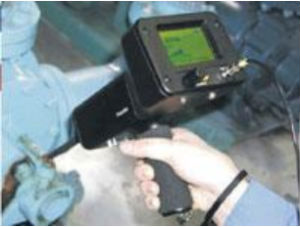- Equipment Nameplates: Compare equipment nameplate data with drawings and specifications.
- Remove Covers: Remove and replace covers on all electrical system components, where applicable.
- Visual and Mechanical Inspections: Interior and exterior of all components will be inspected to ascertain, and if necessary, make certain adjustments to ensure that its performance remains within specified limits. We will also identify corrosion, rust and discoloration, leaks, safety hazards, applicable electric code violations, grounding, physical damage and the general condition of components.
- Installation: Verify appropriate anchorage, required area clearances, physical damage, and correct alignment.

- Ultrasonic Service: Measure and record sound waves with frequencies above audible sound (16-18 kHz). This service is used to complement the infrared service as well as safety and determine if corona, tracking, arcing are present and to assure the quality and integrity of your electrical system.

- Infrared Thermographic Imaging Service: Measure (utilizing state-of-the-art instrumentation) to identify and document temperatures that exceed NFPA Standard 70B recommendations, i.e., high resistance electrical connections, current overload, defective circuit breakers and/or defective insulator conditions. This service is used to reduce the risk of brownouts and blackouts, as well as safety and fire hazards.

- True RMS Voltage and Current Service: Capture and record the square root of the average square of the instantaneous magnitude of the voltage and current. This service is used to determine whether the correct voltage and current is present to properly operate your equipment and optimize its life cycle.
- Voltage Drop Service: Measure and record the difference of voltages at the two terminals of passive impedance. This service is used to determine whether your electrical components -- i.e., circuit breakers, contact surfaces, etc. -- are operating properly to reduce hazards and equipment destruction.
- Voltage and Current Harmonics Service: Capture and record Total Harmonic Distortion-Voltage (THDV) and Total Harmonic Distortion-Current (THDC) that exceed IEEE recommendations. This service is used to determine whether your harmonic contaminations are within tolerance levels. In addition, this service is designed to assure accurate power (kW) charges and to minimize the risk of damage to microelectronic equipment, transformers, circuit breakers, motors, etc.
- Phase-Balance Service: Test to assure that the phases in your electrical system are balanced. This service is used to address unbalanced components that increase power-quality problems, total harmonic distortion, as well as increased temperature rise of devices and current-carrying conductors.

- Insulation Resistance Service: Measure and record the resistance of insulation under specified conditions set forth by manufacturer or NFPA Standard 70B. This service is designed to ensure that your electrical system and components’ insulation values are at an acceptable level, reducing the risk of explosions, fires and catastrophic breakdowns.
- Winding Resistance Service: Measure, record and compare the winding resistance of components. This service will ensure that components are operating to manufacturer’s specifications, extending useful life, and reducing the risk of catastrophic failure.
- Contact Resistance Service: Measure and record the resistances present between contact surfaces. This service addresses poor contact surfaces that would cause increased voltage drop, increased heat and reduced life expectancy, causing brown-outs, black-outs, explosions, fires and catastrophic failures.
- Ground Resistance Service: Measure and record the resistance of conductors, connections and devices. This service will reduce the risk of power quality, harmonic and safety issues.
- Circuit Breaker Service (Low-Voltage): Measure, test, record and document findings regarding all applicable low-voltage circuit breakers. The proper service and inspection of your circuit breakers will reduce the risk of business interruption, fire and catastrophic failure.
- Motor Service: Measure, record and monitor all appropriate service and inspection to manufacturer’s recommendations and/or NFPA Standard 70B. This service and inspection is performed to monitor and trend the motor and to reduce the risk of failure.
- Transformer Service: Measure, record and monitor all appropriate service and inspection to manufacturer’s recommendations and/or NFPA Standard 70B. This service and inspection is performed to reduce the risk of transformer failure, which could result in fire and/or catastrophic failure.
- Transformer Oil Analysis
- Exercising: Exercise all active components (when applicable).
- Check Tightness: Torque all connections and terminations to applicable specifications.
- Lubrication: Lubricate, as appropriate, to assure proper mechanical function(s).
- Cleaning: Clean interior and exterior of equipment, including vacuuming or blowing out as required.
- Analysis: Compare test results and trends in order to determine appropriate actions to minimize the likelihood of an unscheduled business interruption or safety hazard.

Our cloud-based, comprehensive computerized asset management software offers a maintenance solution that adds value to your facility and best hedges your electrical risk. Our preventive data management software offers one-line diagrams, panel schedules, and maintenance analysis in an all-in-one facility tool. This computerized tasking of your electrical gear helps inventory electrical assets, catalogs repair work, and offers baseline data on all of your electrical components.

As a TEGG franchise, BOPAT Electric is your Education Resource in the Baltimore/Washington region. The TEGG Education program offers outside training programs, in-house training programs, Lunch & Learns, as well as literature to educate our customers. These seminars are offered in half-day, full-day or multiple-day formats. Continuing Education Units may be offered in select locations. Training topics include: NFPA 70E Electrical Safety in the Workplace, NFPA 70B Safety-Related Maintenance Requirements, Electrical Preventive Maintenance and Power Quality.

- Repair or Replacement: Repair or replace failed covered component, including all labor and materials, without any additional charges.
- Temporary Power: Provide temporary power if covered failed component cannot be repaired or replaced in a reasonable time.
